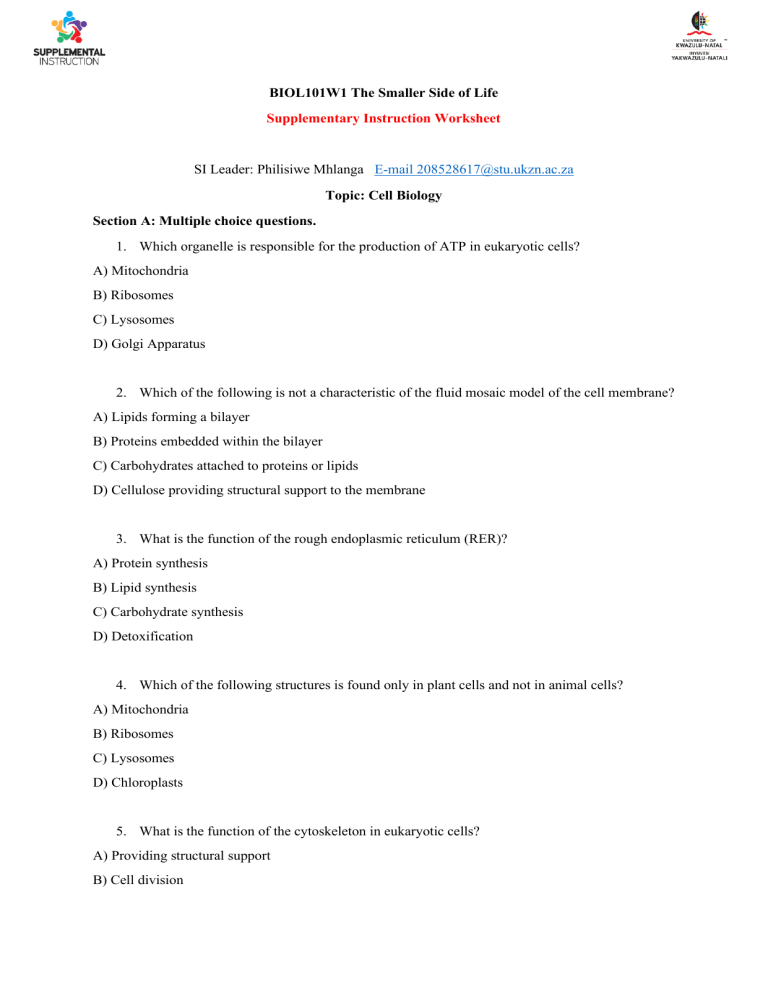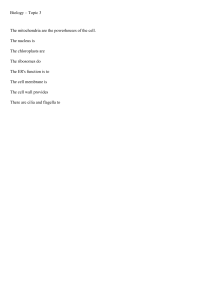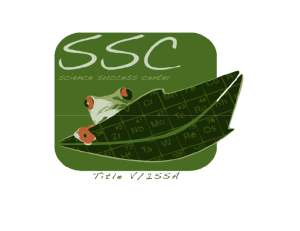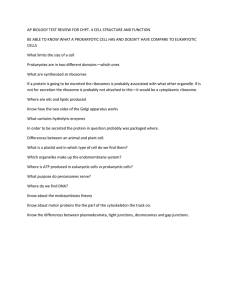
BIOL101W1 The Smaller Side of Life Supplementary Instruction Worksheet SI Leader: Philisiwe Mhlanga E-mail 208528617@stu.ukzn.ac.za Topic: Cell Biology Section A: Multiple choice questions. 1. Which organelle is responsible for the production of ATP in eukaryotic cells? A) Mitochondria B) Ribosomes C) Lysosomes D) Golgi Apparatus 2. Which of the following is not a characteristic of the fluid mosaic model of the cell membrane? A) Lipids forming a bilayer B) Proteins embedded within the bilayer C) Carbohydrates attached to proteins or lipids D) Cellulose providing structural support to the membrane 3. What is the function of the rough endoplasmic reticulum (RER)? A) Protein synthesis B) Lipid synthesis C) Carbohydrate synthesis D) Detoxification 4. Which of the following structures is found only in plant cells and not in animal cells? A) Mitochondria B) Ribosomes C) Lysosomes D) Chloroplasts 5. What is the function of the cytoskeleton in eukaryotic cells? A) Providing structural support B) Cell division C) Intracellular transport D) All of the above 6. Which of the following cell structures is responsible for breaking down cellular waste and foreign substances? A) Mitochondria B) Ribosomes C) Lysosomes D) Golgi Apparatus 7. Who proposed the cell theory? A) Robert Hooke B) Antonie van Leeuwenhoek C) Matthias Schleiden and Theodor Schwann D) Louis Pasteur 8. Which of the following is a key principle of the cell theory? A) All living things are made up of cells B) Cells are the basic unit of life C) All cells come from pre-existing cells D) All of the above 9. What is the function of the nucleus in eukaryotic cells? A) Protein synthesis B) Energy production C) DNA storage and replication D) Carbohydrate synthesis 10. Which type of cell lacks a nucleus? A) Prokaryotic B) Eukaryotic C) Both prokaryotic and eukaryotic cells have a nucleus D) Neither prokaryotic nor eukaryotic cells have a nucleus Section B: True or False 1. The endosymbiosis theory suggests that mitochondria and chloroplasts were once free-living bacteria that were engulfed by ancestral eukaryotic cells. 2. The endosymbiosis theory was first proposed by Lynn Margulis in the 1960s. 3. Mitochondria and chloroplasts both have their own DNA that is distinct from the nuclear DNA of the host cell. 4. The endosymbiosis theory is universally accepted by the scientific community and there is no ongoing debate or research on the topic. 5. The endosymbiosis theory suggests that all eukaryotic cells have both mitochondria and chloroplasts. Section C: Short answer questions 1. What is the endomembrane system? 2. How are proteins transported between organelles within the endomembrane system? 3. What is the function of the Golgi apparatus in the endomembrane system? 4. How do lysosomes function in the endomembrane system? 5. What is the role of the endoplasmic reticulum in the endomembrane system? 6. Consider the below diagram and describe the characteristics of a phospholipid that allow it to function as a major component in the plasma membrane 7. The below diagram depicts the endosymbiosis theory. Describe it. 8. Consider the diagrams depicted below and describe the key role of these transport vesicles in the endomembrane system 9. The eukaryotic cell’s genetic instructions are housed in the nucleus and carried out by the ribosomes. Describe the relationship between the nucleus and ribosomes. 10. Give labels A- J and state the functions of these structures. A B C D E F G H I J






